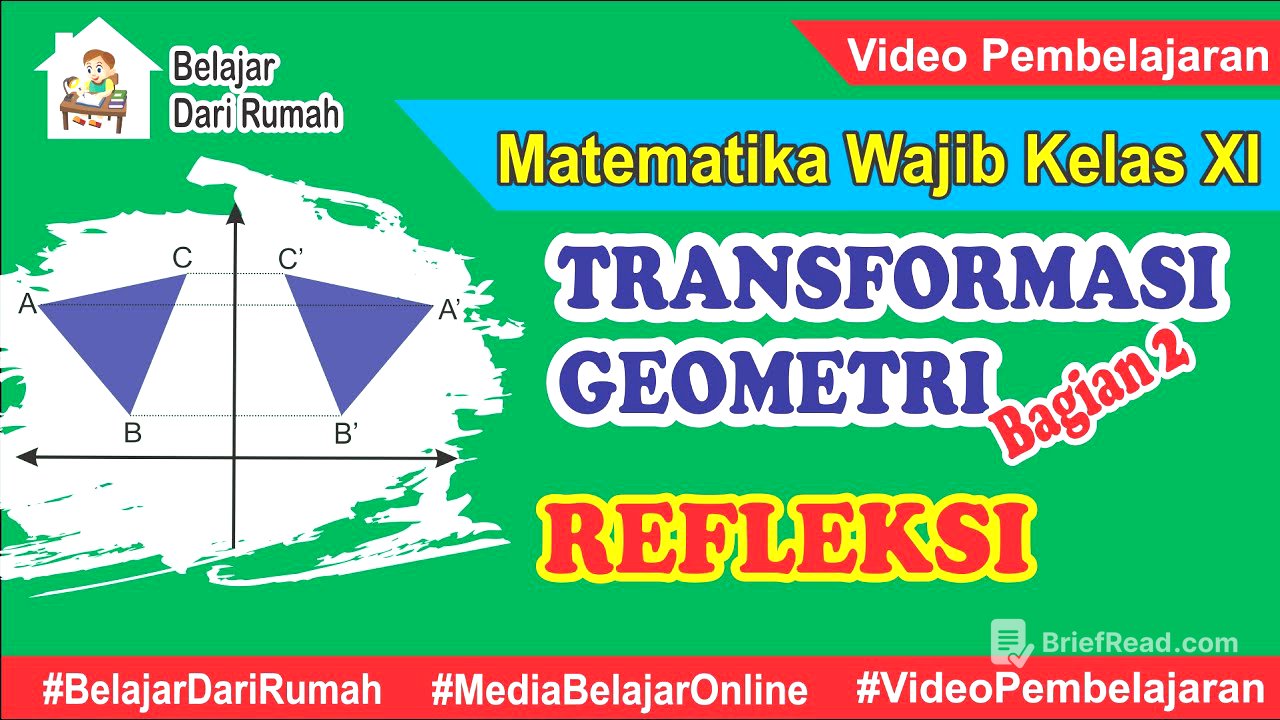TLDR;
This video provides a comprehensive guide to geometric transformations, specifically focusing on reflection (mirroring). It covers reflections across the x-axis, y-axis, lines y = x, y = -x, the origin (0,0), and lines x = h and y = k. The video also explains how to solve reflection problems using matrices and includes several example questions to illustrate the concepts.
- Reflection across various axes and lines
- Solving reflection problems using matrices
- Practical examples and problem-solving techniques
Introduction to Reflection [0:39]
The video introduces reflection, also known as mirroring, as the second geometric transformation to be discussed, following a previous video on shifting or translation. Instead of directly presenting formulas, the video aims to help viewers discover these formulas themselves through examples. This approach is intended to aid in remembering and understanding the concepts.
Reflection Across the X-Axis [1:01]
The video explains reflection across the x-axis using a Cartesian diagram. A point A (4,2) is reflected across the x-axis, resulting in a new point (4,-2). The x-coordinate remains the same, while the y-coordinate changes sign. Generalizing this, a point (x, y) reflected across the x-axis becomes (x, -y). For example, the point (2,-6) reflected across the x-axis becomes (2,6).
Reflection Across the Y-Axis [2:41]
The video explains reflection across the y-axis. Using point A (4,2), reflecting it across the y-axis results in the point (-4,2). Here, the x-coordinate changes sign while the y-coordinate remains the same. In general, reflecting a point (x, y) across the y-axis results in (-x, y). For instance, reflecting the point (6,-4) across the y-axis yields (-6,-4).
Reflection Across the Line y = x [3:52]
The video discusses reflection across the line y = x. Point A (4,2) reflected across this line becomes (2,4). The x and y coordinates are interchanged. Thus, a point (x, y) reflected across the line y = x becomes (y, x). As an example, the point (2017, 2016) reflected across y = x becomes (2016, 2017).
Reflection Across the Origin Point (0,0) [5:11]
The video explains reflection across the origin point (0,0). Reflecting point A (4,2) across the origin results in (-4,-2). Both the x and y coordinates change signs. Therefore, a point (x, y) reflected across the origin becomes (-x, -y).
Reflection Across the Line x = h [6:16]
The video covers reflection across the line x = h. Using x = 2 as an example, point A (4,2) is reflected to a new position. The x-coordinate changes based on the formula 2h - x, while the y-coordinate remains the same. Thus, reflecting (x, y) across x = h results in (2h - x, y). For example, reflecting (4,2) across x = 2 gives (2*2 - 4, 2) = (0,2).
Reflection Across the Line y = k [7:56]
The video explains reflection across the line y = k. Using y = 3 as the mirror line, the x-coordinate remains unchanged, while the y-coordinate transforms to 2k - y. Therefore, reflecting a point (x, y) across y = k results in (x, 2k - y). For example, reflecting (2,6) across y = 1 yields (2, 2*1 - 6) = (2, -4).
Reflection Across the Line y = -x [8:58]
The video discusses reflection across the line y = -x. Reflecting point A (4,2) across y = -x results in (-2,-4). Both coordinates are swapped and change signs. Thus, reflecting (x, y) across y = -x results in (-y, -x).
Solving Reflections Using Matrices [10:04]
The video transitions to solving reflection problems using matrices. It emphasizes the importance of remembering the transformation matrix for each type of reflection. The transformation matrix for reflection across the x-axis is [[1, 0], [0, -1]], and for the y-axis, it is [[-1, 0], [0, 1]]. For y = x, the matrix is [[0, 1], [1, 0]], and for y = -x, it is [[0, -1], [-1, 0]]. Reflection across the origin uses [[-1, 0], [0, -1]]. The video also provides the matrix for reflections across x = h.
Example Question Using Matrices [12:40]
The video presents an example question: determining the coordinates of the image of point B (6,3) reflected across the line y = -x. The coordinates of the image (x', y') are found by multiplying the transformation matrix for y = -x, which is [[0, -1], [-1, 0]], with the original coordinates (6,3). The calculation results in (-3, -6).
Reflection of a Line or Curve [14:39]
The video moves on to the reflection of a line or curve, providing an example question: determining the equation of the shadow of the line 3x + 2y - 1 = 0 when reflected across the line y = x. The transformation involves swapping x and y, leading to the reversed identity matrix [[0, 1], [1, 0]]. By substituting x' = y and y' = x into the original equation, the new equation becomes 2x + 3y - 1 = 0.
Example Questions with Different Forms [16:27]
The video presents several example questions with different forms to reinforce the concepts.
- Question 1: Point A is reflected across the line x = 1, resulting in A' (-1, 2). Find the coordinates of point A.
- Question 2: Triangle PQR with coordinates P(3,2), Q(-1,0), and R(-3,4) is reflected across the line y = x. Find the coordinates of the reflected triangle P'Q'R'.
- Question 3: Point P(2,-5) is reflected across the line y = -x and then across the y-axis. Find the final coordinates.
- Question 4: Point A(-2,-4) is reflected across the line x = p and then across the line y = q, resulting in A''(6,-2). Find the value of 3p + 4q.
- Question 5: The line y - x + 1 = 0 is reflected across the line y - 1 = 0. Find where the reflected line intersects the x-axis.
- Question 6: The line 3x + 4y = -12 is reflected across the y-axis. Find the equation of the reflected line.
- Question 7: The line 2x - y - 4 = 0 is reflected across the line y = x and then across the x-axis. Find the equation of the final reflected line.









